Amir H. Fallah’s beautiful objects reflect a shadow side, a decay of borders, trust, and stability that comes with the trauma of immigration.
LOS ANGELES — This city is neither a melting pot nor a salad. A cultural melting pot implies that the cultures blend and merge into one, making them indistinguishable from each other. A cultural salad implies that that the cultures remain distinct, even while creating a singular whole that can be interesting because of the combination.
Los Angeles is, instead, a good stir fry — mixing, merging, blended flavors and ingredients that maintain distinctness while invariably changing each other. And like a good stir fry, the recipe for being an Angelene varies by family.
 Installation view, Amir H. Fallah: The Fallacy of Borders, January 29–May 14, 2023, The Fowler Museum at UCLA, Los Angeles.
Installation view, Amir H. Fallah: The Fallacy of Borders, January 29–May 14, 2023, The Fowler Museum at UCLA, Los Angeles.
Los Angeles artist Amir H. Fallah, who arrived in the city by way of Tehran and then Turkey, understands this deeply. In “Cowgirl,” a large circular painting that contains the eponymous figure, Fallah combines a range of symbologies into a stir fry that feels at once of the city and a challenge to what the city represents.
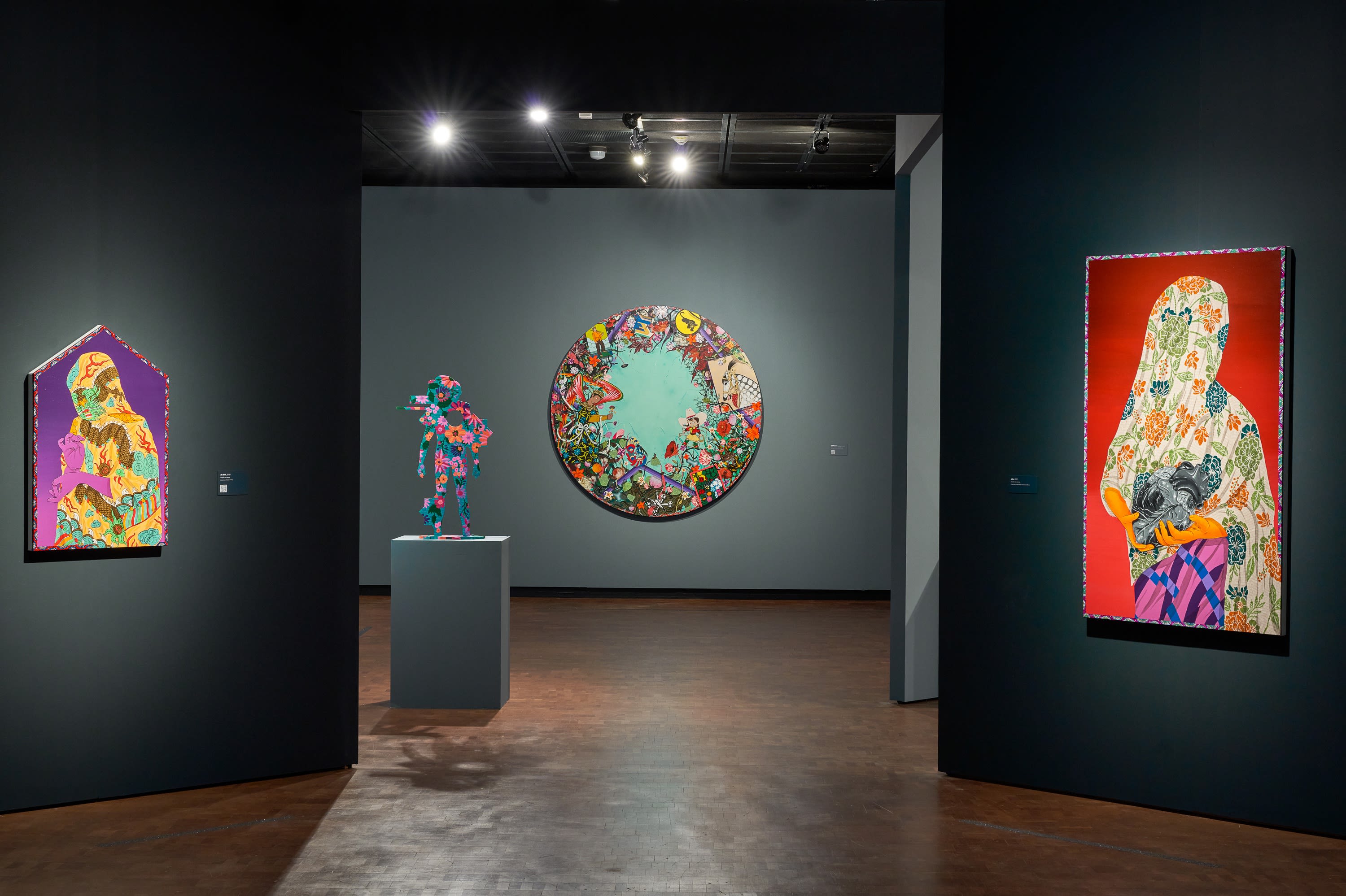
INSTALLATION VIEW, AMIR H. FALLAH: THE FALLACY OF BORDERS, JANUARY 29–MAY 14, 2023, THE FOWLER MUSEUM AT UCLA, LOS ANGELES.
“For the artist,” the exhibition text explains, “the flourishing flora around this tondo’s perimeter serves as a metaphor for the American promise of fertile soil and opportunities for all.” Alongside the anime-like cowgirl, a Black Panther logo, a traditional West or South Asian figure, and a gilded horse all come together — questioning the idyllic promise of the cowgirl. The work is in the style of a tondo, or Flemish garland painting, which usually contains a portrait within the frame. Fallah has left it blank with turquoise.
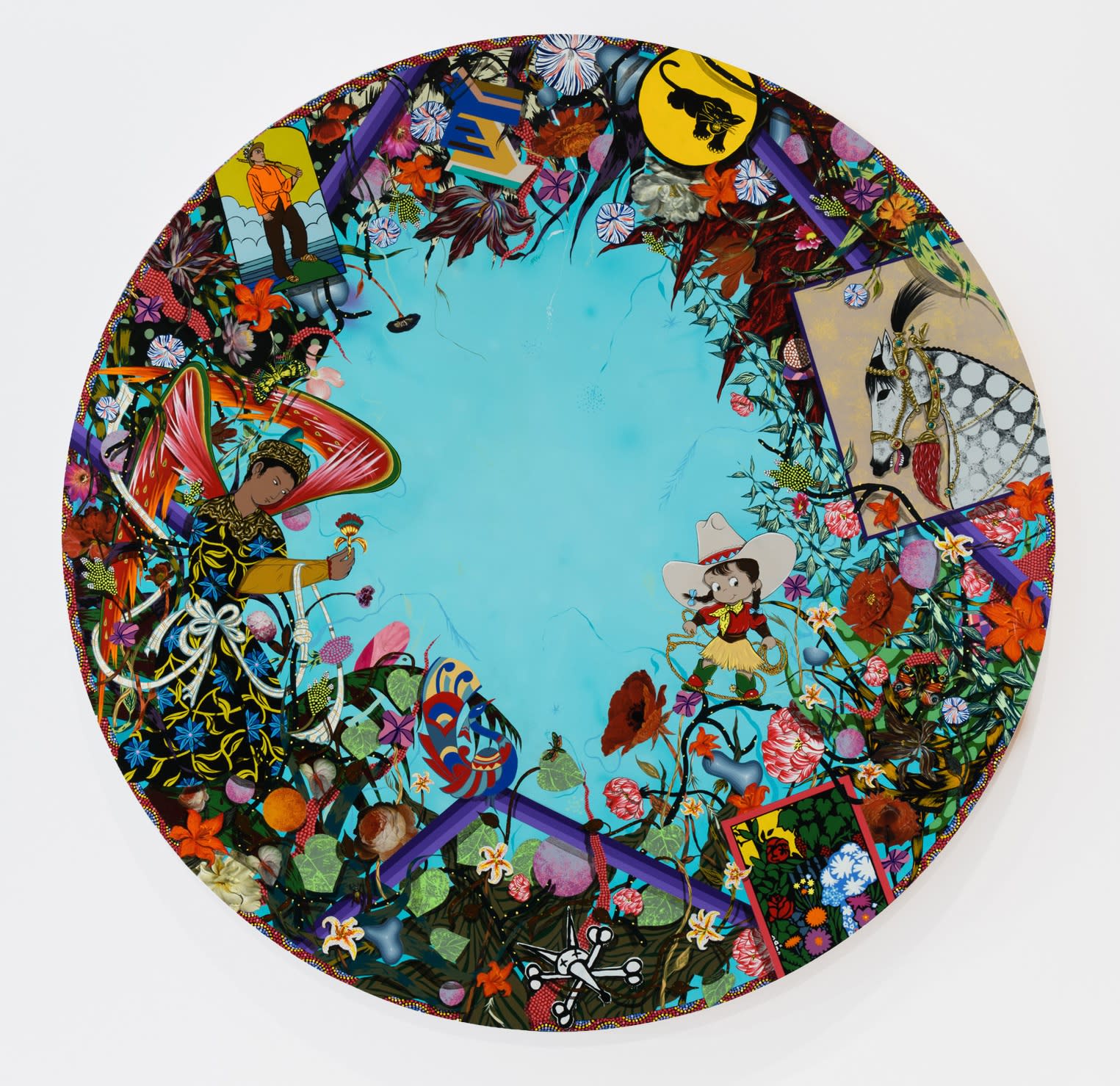
Amir H. Fallah, Cowgirl, 2020. Acrylic, spray paint, and collage on canvas. 72 x 72 inches. IMAGE COURTESY OF THE ARTIST AND SHULAMIT NAZARIAN.
The Fallacy of Borders, on view at the UCLA Fowler Museum through May 14, is the first solo exhibition of the artist, whose bold, bright paintings, sculptures, and stained glass pieces communicate a rich array of cultures, perspectives, and influences, all formed by the many diasporas that shape Los Angeles, alongside his own cultural heritage as Iranian American.
The show is organized by major themes: New Worlds | Old Worlds; Sculptures; Portraiture; Allegory; Autobiography and Canvas | Stained Glass; and Objects | Memories. The thematic arrangement helps us filter the works through the perspective of major influences in Fallah’s life. In the Portraiture section, for example, we see his interest in the primacy of objects and gestures in shaping identity. If his tondos challenge the idea of centrality implicit in a circle, his portrait series challenges the idea that a subject need be identifiable by their face.
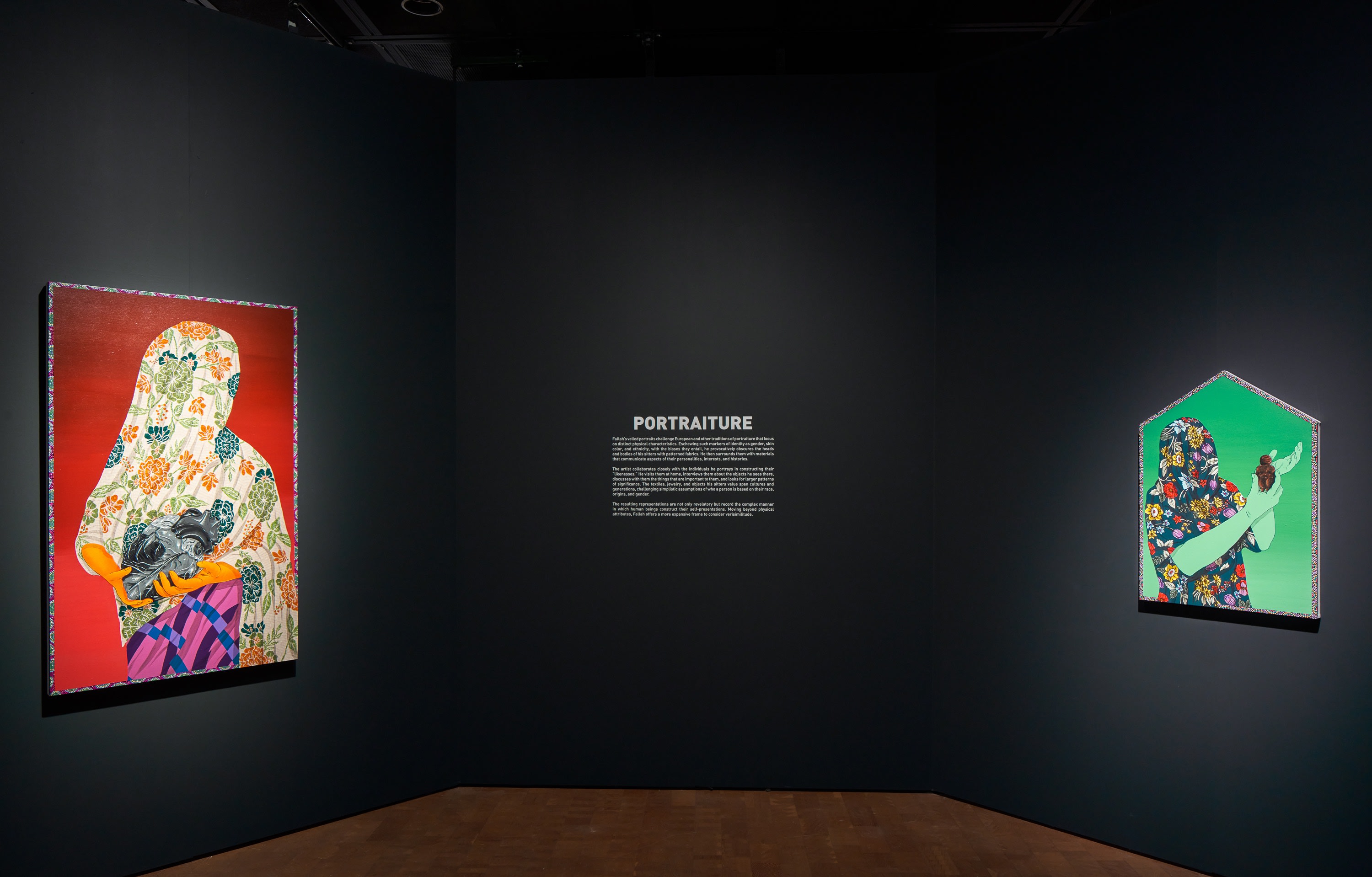
INSTALLATION VIEW, AMIR H. FALLAH: THE FALLACY OF BORDERS, JANUARY 29–MAY 14, 2023, THE FOWLER MUSEUM AT UCLA, LOS ANGELES.
In “Life,” a figure under cloth holds a gray heart, its valves and chambers on full display, and in “Be Still,” another figure holds its hands in the dharmachakra mudra, or mudra of teaching. The figures’ arms are yellow and violet, respectively, their faces hidden under colorful prints. Race, gender, class, and other markers fade away, as Fallah instead represents his subjects through the objects around them, after meeting with the sitters to discuss what’s important to them. The Autobiography section offers a glimpse into the artist’s immigration journey. His painting “No Gods No Masters” includes depictions of Middle Eastern stereotypes, such as Aladdin on a flying rug, and a Nosferatu-like specter behind a 1920s flapper in a red dress.
Amir H. Fallah, No Gods No Masters, 2020. Acrylic on canvas. 60 x 60 inches. Image courtesy of the artist and Shulamit Nazarian.
His monumental work “Break Down the Walls” contains a litany of symbols and images that speak to the show’s title, representing the struggles of immigration, especially in a hostile environment. “I made this sketch,” Fallah explained in the exhibition audio, “during the last year of the Trump presidency. Watching the news I was devastated by what was happening at the US-Mexico border.” It reminded him of his own experience coming to the United States, and he wondered how his life might have played out differently had his and his family’s access been denied in a similar way. The work’s title references the music of hardcore band Youth of Today, whose themes of immigration continue to inform his politics.
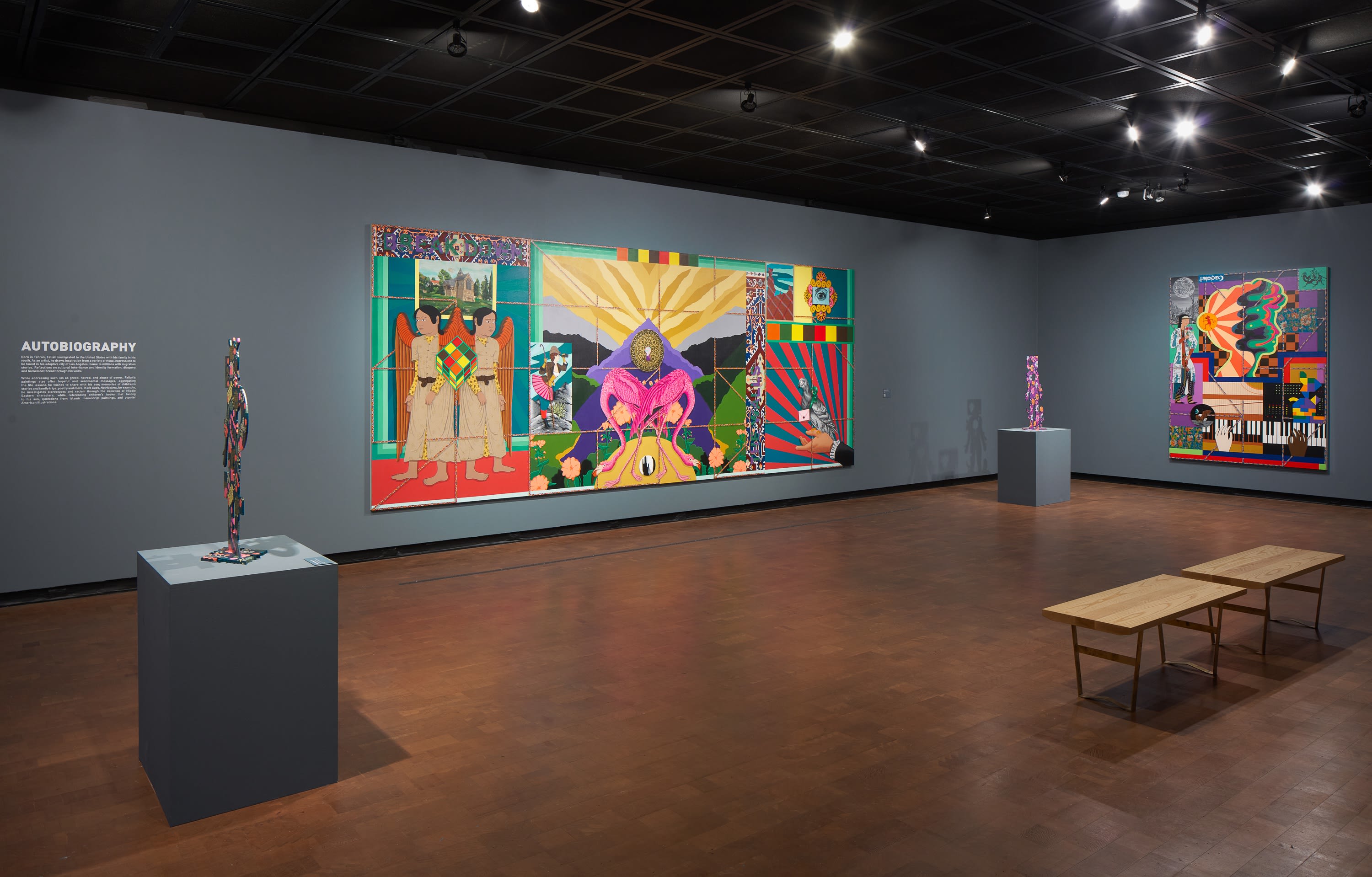
INSTALLATION VIEW, AMIR H. FALLAH: THE FALLACY OF BORDERS, JANUARY 29–MAY 14, 2023, THE FOWLER MUSEUM AT UCLA, LOS ANGELES.
A keyhole at the center opens out to an alternative life: a dove represents messages, angels reflect good and evil, and a traveler looks off into the distance. Fallah calls them symbols, but to me they also read as archetypes, connecting the modern-day experience of immigration with the ancient experiences of wandering, nomadism, migration, and loss. “These symbols represent the complex situations that all countries deal with surrounding the issue of immigration,” he noted of his painting. “Who is allowed in and who is kept out. Who is safe and who is in harm’s way. And most importantly, who gets to decide.”
 INSTALLATION VIEW, AMIR H. FALLAH: THE FALLACY OF BORDERS, JANUARY 29–MAY 14, 2023, THE FOWLER MUSEUM AT UCLA, LOS ANGELES.
INSTALLATION VIEW, AMIR H. FALLAH: THE FALLACY OF BORDERS, JANUARY 29–MAY 14, 2023, THE FOWLER MUSEUM AT UCLA, LOS ANGELES.
Scattered throughout the show are sculptures, each made of hand-painted sheets of aluminum. They continue the visual themes of the paintings, with cutouts that represent various organs. From far away, and even up close, they look more delicate, as if made of cardboard rather than metal. They are complemented by the gorgeous stained glass pieces he developed with Judson Studios, established in 1897 in Los Angeles and the country’s longest-operating stained glass workshop. The textures of both the sculptural and glass works bring to life the bold color choices and iconography of Fallah’s art.
Rounding out the show is an array of covers of Beautiful/Decay, an art and design magazine that Fallah led as editor-in-chief and creative director while completing his MFA at UCLA. Donated by photographer Fubz, a longtime collaborator, the magazine covers show the artist’s wide interests and creativity, and a selection of Beautiful/Decay hoodies from artists and galleries like Aya Kato and Deitch Projects reflect the bold pop of the moment.
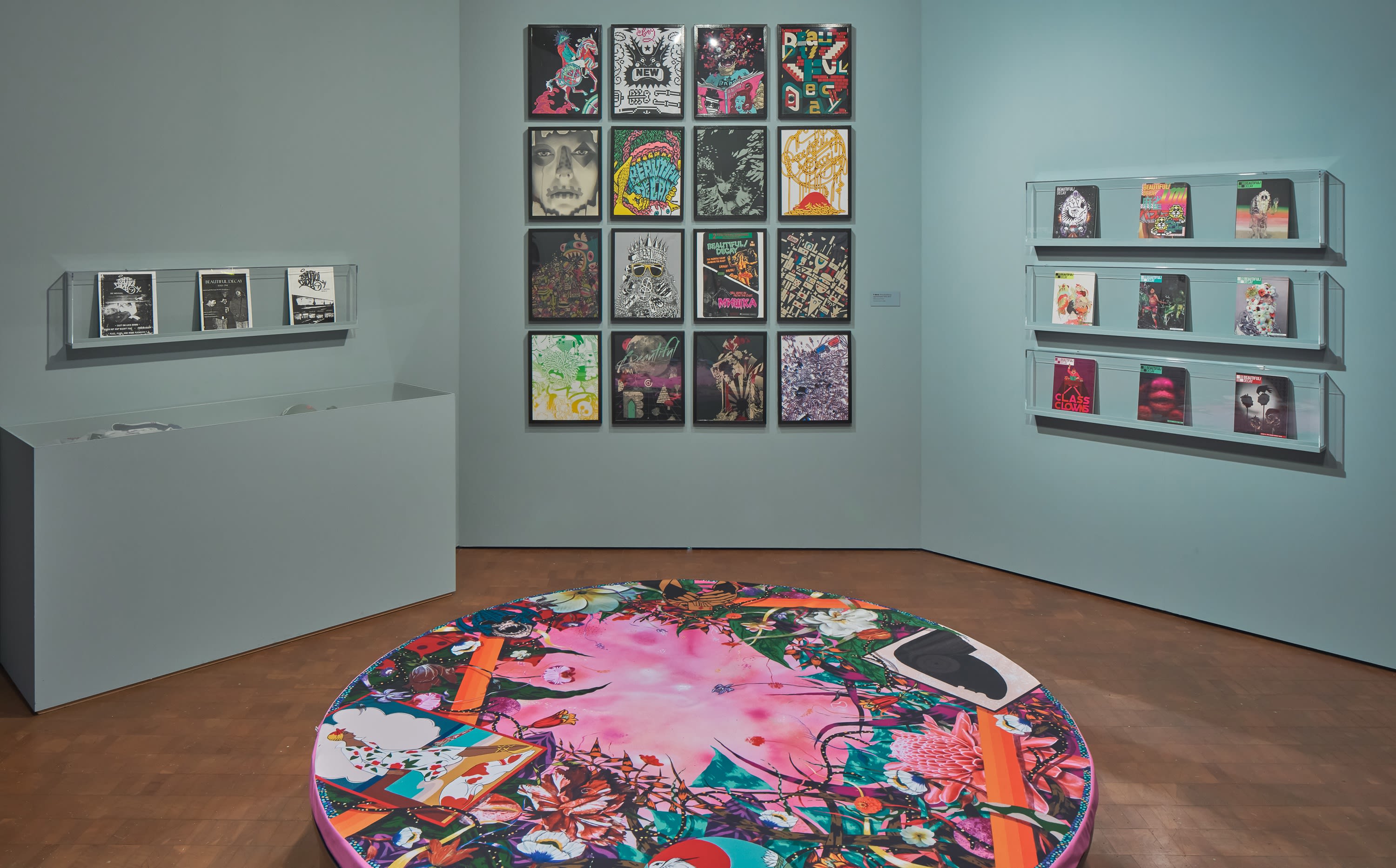
INSTALLATION VIEW, AMIR H. FALLAH: THE FALLACY OF BORDERS, JANUARY 29–MAY 14, 2023, THE FOWLER MUSEUM AT UCLA, LOS ANGELES.
“Beauty and decay” is, perhaps, the best way to describe the yin and yang of Amir H. Fallah’s work. Aesthetically speaking, his pieces are sumptuous, beautiful, and inspiring, breathing life into the symbols and subjects he chooses to paint. But the themes he explores reflect a shadow side, a decay of borders, trust, and stability that comes with the trauma of immigration and of existing in a country with a growing culture of rhetoric and violence against immigrants.

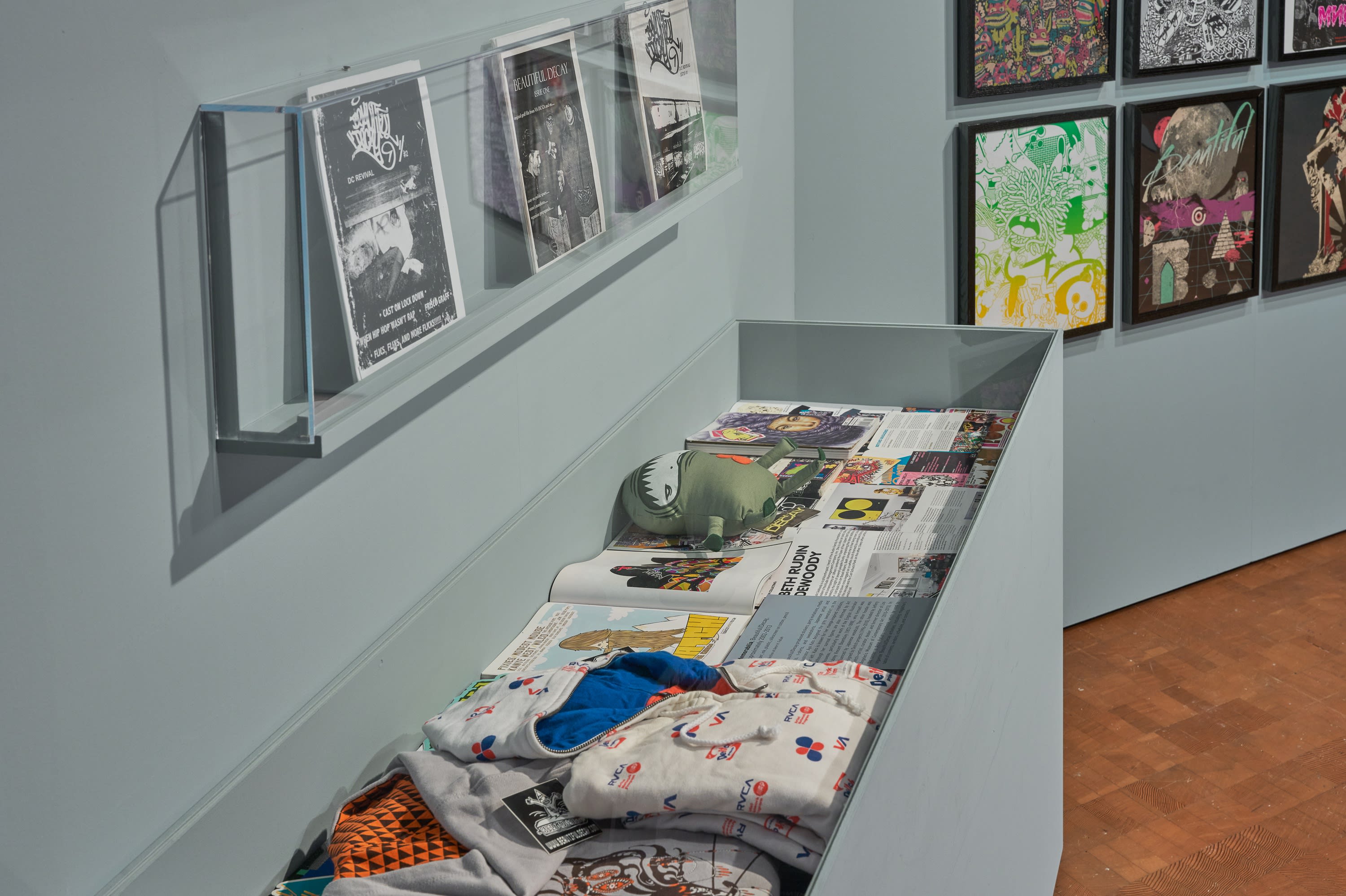 (top and bottom) INSTALLATION VIEW, AMIR H. FALLAH: THE FALLACY OF BORDERS, JANUARY 29–MAY 14, 2023, THE FOWLER MUSEUM AT UCLA, LOS ANGELES.
(top and bottom) INSTALLATION VIEW, AMIR H. FALLAH: THE FALLACY OF BORDERS, JANUARY 29–MAY 14, 2023, THE FOWLER MUSEUM AT UCLA, LOS ANGELES.
In “Protector 1,” a cloaked figure holds what looks like an Egyptian bust, and in the distance a Japanese woodblock-style print features another figure gazing out from a cliffside onto water. According to the exhibition text, the painting is about the downsides of cultural preservation, which so often entails taking cultural heritage from one country in order to showcase it in another. But in the context of this show and its themes I tend to see it another way: as an immigrant holding onto whatever piece of the past they can, knowing it, too, could one day be taken away.



